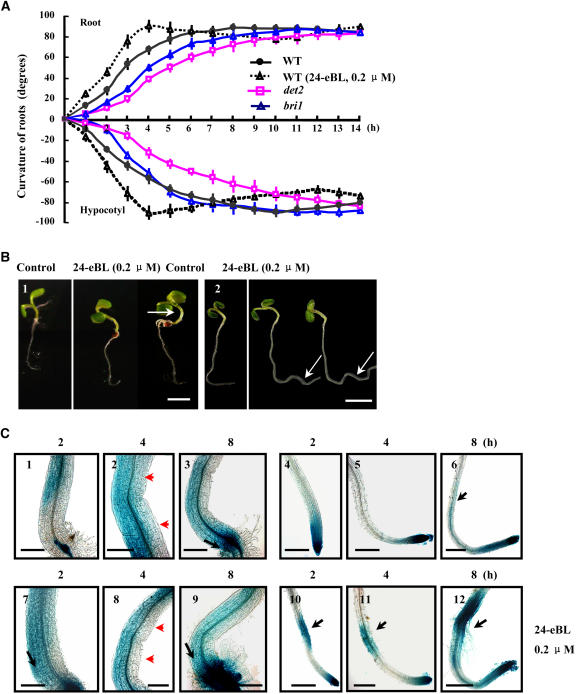Figure 4.
Regulation of Plant Tropism by BL.
(A) Time course of curvature in seedling tropistic responses. Four-day-old Arabidopsis wild-type (in the absence or presence of 0.2 μM 24-eBL) or BR-related mutant (det2 and bri1) seedlings, treated with a 90° horizontal reorientation and unilateral topside light stimulus, were used for measurement. The curvature of seedlings was calculated every 60 min after the reorientation and analyzed statistically. n > 20 for each treatment, and error bars show sd. P < 0.05 determined by the one-tailed Student's t test. Please note that symbols may cover some bars.
(B) BR caused the enhancement of hypocotyl bending and root curving during tropistic responses. Four-day-old Arabidopsis seedlings were treated with DMSO (Control; left) or 24-eBL (0.2 μM; right) after a 90° horizontal reorientation for 8 h (1) and 14 h (2) after treatment. Arrows indicate the bent hypocotyls (1) and the second curves of roots (2) in the BR-treated seedlings. Bars = 4 mm.
(C) Altered auxin distribution in plant shoots (1 to 3 and 7 to 9) and roots (4 to 6 and 10 to 12) in response to gravity. Four-day-old DR5-GUS–harboring Arabidopsis seedlings were treated with a 90° horizontal reorientation, and GUS activities were detected after 2 h (1, 4, 7, and 10), 4 h (2, 5, 8, and 11), and 8 h (3, 6, 9, and 12). 24-eBL (0.2 μM) was added during the process (7 to 12). Statistical analysis indicated that the proportions of seedlings showing asymmetric expression of GUS were ∼67.7% (2 h), 63% (4 h), and 58.5% (8 h). n > 100 for each treatment, repeated in triplicate. Black arrows highlight the enhanced GUS expression downward to the shoot–root junction, and red arrowheads indicate the obviously asymmetric auxin distribution. Bars = 200 μm.

